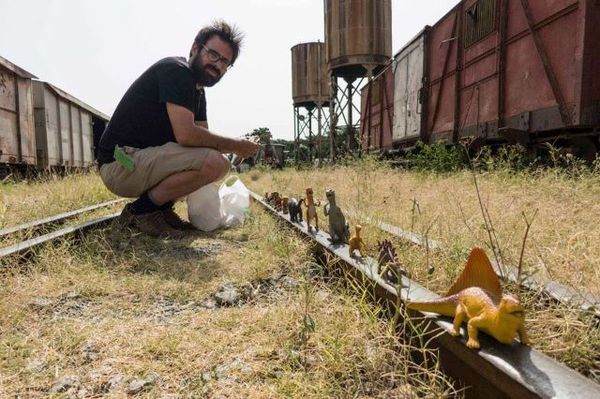 |
| Crumbs director Miguel Llansó: 'On a concrete level, Crumbs is the story of an anti-Cinderella' |
RN: During the presentation of the film at the D'A Festival, programmer Carlos Losilla said Chigger Ale was a precursor of Crumbs - but what was the starting point for the narrative in the feature film?
ML: The feature started from several points. Of course from Chigger Ale, this whole universe, this reflection on where we're going in this world of globalisation, of objects losing their meaning, the dislocation felt by people in an incomprehensible world, and this made it also about the differing relations between people and icons. For example, the icon of Cristiano Ronaldo or the icon of Beyoncé are normal objects in society, but when you remove them from this habitat and put them in an exotic locale, you give them a different significance and you can think about them.
So we're attempting to make a reflection, because you see this in Addis Ababa - if you go into the street, it's easier to find a Beyoncé CD than a CD of Mahmoud Ahmed, who is one of the stars of Addis Ababa music. So, it's partly a reflection of this dislocation of relations in the contemporary world. On a concrete level, Crumbs is the story of an anti-Cinderella because we're accustomed to North American cinema and the capitalist structure of stories about success - a poor girl, Cinderella, in the end discovers the rich man - or Pretty Woman, where she is saved and converted into a kind of princess - and it's a discourse about capitalism.
A lot of people playing the lottery, only one will triumph, and the one who triumphs is converted into an example for everyone who doesn't win. So Crumbs is the subversion or transformation of this so that it signifies the opposite - someone who believes that he is Superman and who at the end has to accept that he isn't. So at the same time, there's a sensation of science fiction and strange places, but also a very human story of two people who in the end have to accept who they are in reality. And they're not great heroes, but it's not so bad not being a hero - that's part of the background to the film.
RN: Why Ethiopia? I know that you live there for part of the year, but what attracted you to the country and why did you make your film there?
ML: I moved to Ethiopia in 2008 because I was convinced that the media had drawn a very simplistic reality of Africa and Ethiopia. I liked the adventure films of Jean Rouch or Werner Herzog and I wanted to live my own adventures there. So I got a grant to work at the Spanish Embassy and discovered a fascinating country, like I never would have imagined. I met other filmmakers there, like Yohannes Feleke, Daniel Taye Workou and Meseter Argaw, who have produced my films. The cinema is an emerging industry in Ethiopia.
RN: When a film takes place in the future - or in the past for that matter - there is often an allegorical connection with the present. At the (Im)Possible Futures colloquium in Barcelona you spoke about sci-fi as a reflection of everyday life, or as a way of seeing the present more clearly - what did you want to say about today through Crumbs?
 |
| Miguel Llansó: 'We wanted to film an Ethiopia with this flat light but with a lot of colour, and a lot of green' |
RN: I was thinking after the colloquium - in relation to what you said about the changing meaning of objects - about the invention of tradition. How it's not simply invented - it also has to be maintained - but it won't stay exactly the same because the interpretations of that tradition always change in subtle ways, in general so as to benefit those in power or a support a narrative of some sort...
ML: Of course, and a lot of the time a story is told from a certain place. The same story can be told in different ways and it depends a bit on the interests of the person telling it. Many times, what might be of interest to historians, might not necessarily be about the preservation of power. But a lot of the time, the people who govern us tell the story as a defence of the power they represent. And this happens - How are we going to construct this story? Which elements are we going to leave out? Why is the story about the kings and not the story of the people? Why don't we retrieve history from other points of view? The history of feminism, is that not a subversive history? So, this [choice of the point of view] always happens. Then from the future, how do we construct the story of what we've decided to choose? How do we interpret it when there is no frame of reference?
RN: Within the film these objects are reinterpreted because they're outside of their original context, so they can be used to signify other things.
ML: Exactly. But I think that in this poetic significance, it can be comic because it encounters a relation with reality. That is to say, Michael Jordan as God - well, there is a sense in which he is. It also relates to surrealism a bit as well and the films of Buñuel, above all the early ones - well, all of them in general - but particularly Un Chien Andalou and L'Age d'Or. But Un Chien Andalou is a clear example of where symbols transform in a random way, creating significances with a lot of humour but at the same time profoundly subversive and critical.
RN: I really like the aesthetic of the film. There are some beautiful images but at the same time it also looks very realistic and the special effects are very subtle - for example, the spaceship looks like it pertains to the reality of the film. How did you decide on the look of the film?
![Miguel Llansó: 'The spaceship in reality is my town's [holy] relic'](/images/newsite/Crumbs_poster2_225.jpg) |
| Miguel Llansó: 'The spaceship in reality is my town's [holy] relic' |
RN: This is a slightly odd question, but the light in the film - which seemed to me to be... I was going to say 'soft' but I don't think that's quite what I mean, but it's a very particular kind of light - is that simply the light of Ethiopia, or is it something that was created by you and your team?
ML: We shot the film at the start of the rainy season. Normally, it's a light like Barcelona - the sun with clouds - it's a very flat light. Very flat outside. For example, at other times the light is very strong because the sun gets very high very quickly - because it's almost on the equator, so it rises quickly and is very strong light. It's difficult for the cameras because of the latitude, so you have to film very early in the morning or very late in the afternoon. So we had to try to film between rain and sun. The places we filmed in were very green because it had been raining, and we wanted to film an Ethiopia with this flat light but with a lot of colour, and a lot of green.
In the second part of our interview, we talk to Llansó about what the future holds for him and the "other Spanish cinema".
Translated from Spanish by Rebecca Naughten





















